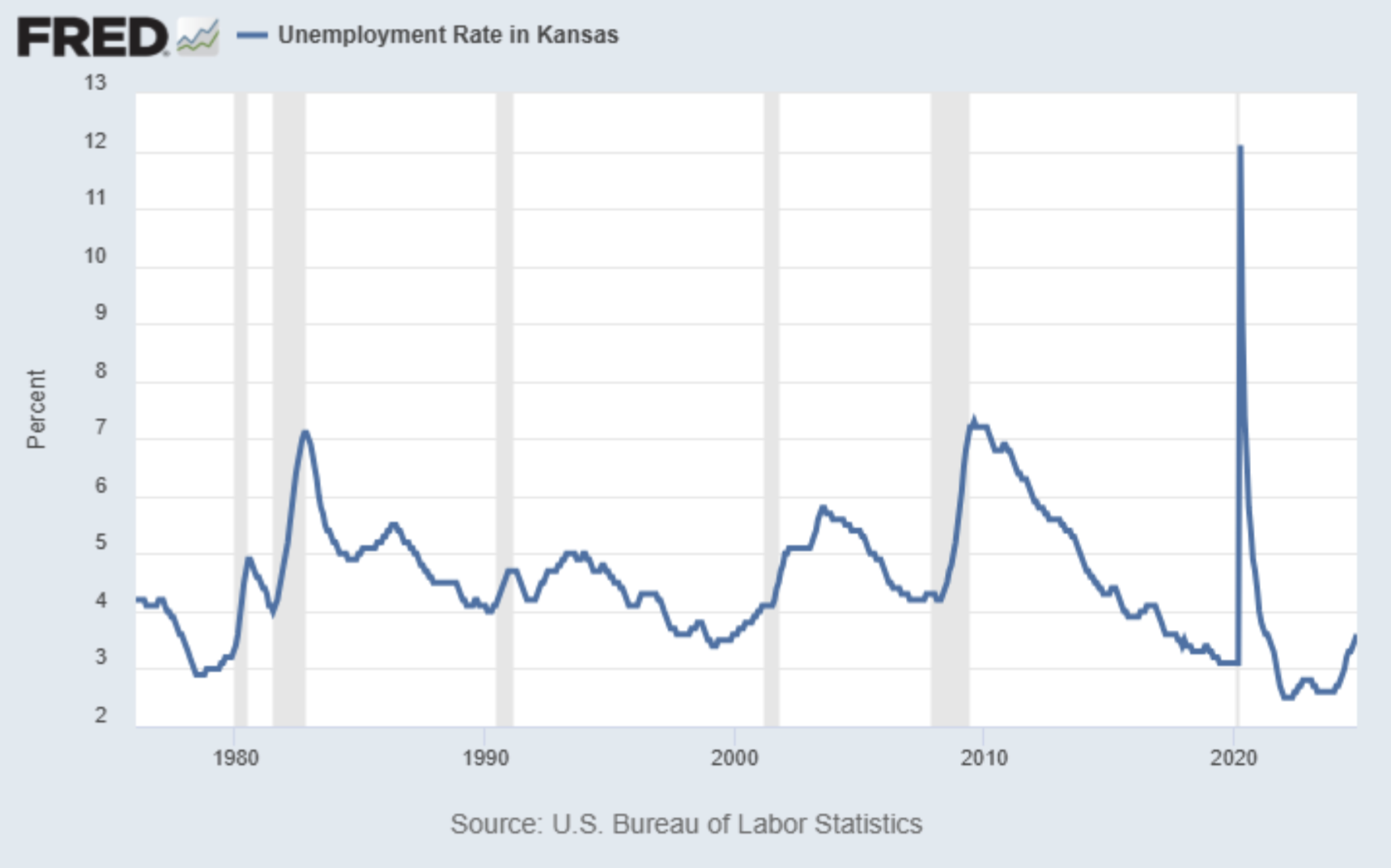Kansas’ labor market saw notable shifts in 2024, reflecting economic resilience and challenges that highlight the need to reduce government size and scope through lower spending, taxes, and regulations. The latest Kansas Department of Labor and Bureau of Labor Statistics data show increased jobs over the year. Unfortunately, more of those jobs were in government than in the private sector in December. A trend that, if continued, threatens long-term fiscal sustainability.
Labor Market Overview
According to the Kansas Department of Labor, the state’s seasonally adjusted unemployment rate rose to 3.6% in December 2024, up from 3.5% in November and 2.6% in December 2023. This substantial increase over the last year raises concerns about the stability of the labor market and can indicate a recession.

The state added 18,400 nonfarm jobs over the year, including 13,300 private sector positions and 5,100 government jobs. In December, Kansas saw an increase of 1,200 nonfarm jobs, with 500 in the private sector and 700 in government. These figures indicate a growing economy and a government sector that continues to expand faster than the private sector.
How Kansas Compares to Nearby States and National Trends
Nationally, the U.S. unemployment rate remained stable at 4.1% in December 2024, up slightly from 3.8% in December 2023. The nation added approximately 2.2 million jobs over the year.
Regionally, Kansas’ unemployment rate of 3.6% puts it in the middle of the pack:
- Missouri: 3.7%
- Nebraska: 2.8%
- Oklahoma: 3.3%
- Colorado: 4.4%
Despite Kansas’ relatively low unemployment rate, its government job growth outpacing private sector job growth is concerning. The best way to foster sustained economic expansion is to create an environment that encourages private-sector investment and job creation—not larger government payrolls paid by the productive private sector.
Implications for Fiscal Policy
The Kansas labor market’s private sector growth presents an opportunity to implement policies that reduce the tax burden, curb government spending, and remove regulatory barriers. The addition of 5,100 government jobs over the past year underscores the importance of reining in government expansion before it becomes an unsustainable burden on taxpayers.
One positive step toward tax relief is the push to lower the state’s individual income tax rate to 4.5%. This move would enhance competitiveness and attract more businesses and workers to the state. Additionally, in 2024, Kansas raised the property tax exemption from $40,000 to $75,000, providing homeowners relief from rising tax burdens. Building on this, policymakers should prioritize broader tax reforms to ensure Kansas remains attractive for businesses and workers.
Regulatory Reform and Economic Growth
Beyond tax relief, reducing regulatory burdens is critical to ensuring Kansas remains competitive. Excessive regulations discourage investment, limit job creation, and raise costs for small businesses. A streamlined regulatory approach would lower compliance costs, attract new enterprises, and encourage business expansion.
A Path Forward for Kansas
The growth in Kansas’ private sector jobs is a sign of economic progress, but the simultaneous expansion of government employment poses risks. Rising tax burdens will eventually hinder long-term economic growth without effective, strict limits on government spending. The current momentum provides an opportunity to:
- Cap government spending to prevent unchecked budget growth.
- Lower the individual income tax rate to keep Kansas competitive.
- Expand regulatory reforms to encourage investment and job creation.
Conclusion
Kansas’ labor market performance in 2024 presents both opportunities and challenges. The state’s economy added 18,400 new jobs over the year, and the unemployment rate soared to 3.6%. To ensure long-term prosperity, Kansas lawmakers must focus on tax relief, spending limits, and regulatory reform. These policies will create a more dynamic economy that benefits businesses and residents.





